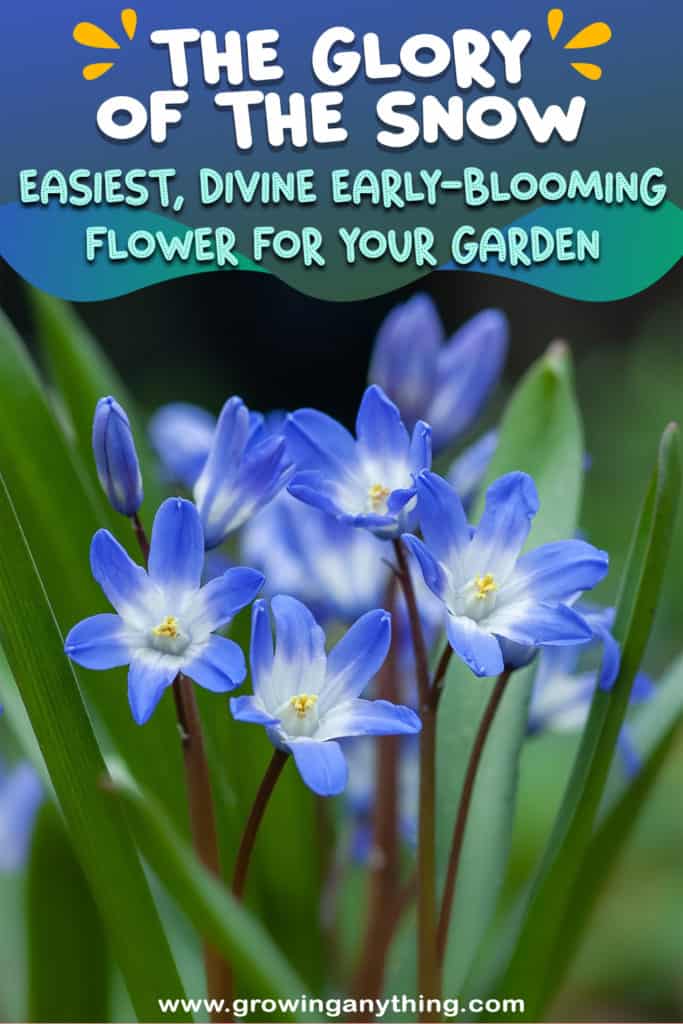How to Plant and Grow Glory-of-the-Snow
The glory of the snow is something we all love to see when the winter finally ends. It announces the beginning of the spring with its gentle, star-shaped flowers.
This bulbous perennial is among the easiest plants to grow in your garden. Today, I will be sharing useful information and tips on the growing the glory of the snow flower.
Despite its pretty appearance and simple maintenance, the glory of the snow is often underrated and skipped. But, once you learn how easy it is to grow and care for and enjoy its pleasant look, you will want it!
The Glory of the Snow Basic Information
The glory of the snow belongs to the Lily family and originally comes from Turkey and Cyprus. If you have ever seen the stunning images of the alpine Turkey region with the snowy white landscape in the early spring – it was the glory of the snow.
The botanical name is Chionodoxa siehei. The plant grows in Zone 3 and is a hardy plant, which needs almost zero-maintenance.
It got its name from tiny flowers with six petals that resemble snowflakes. You can find it with flowers in different shades of blue, pink, lavender, white with yellow anthers, etc. All shades are gentle and delicate, but the plant is resilient and can withstand different conditions.
At the beginning of March, the plants bloom for several weeks and then disappear until the same period next year.
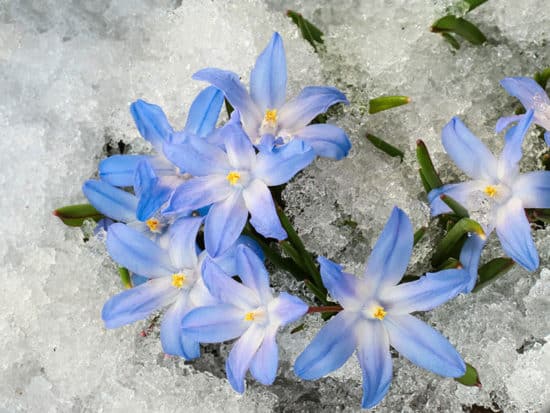
The Glory of the Snow Varieties
Just like other flowering plants, there are multiple varieties of this plant. The primary difference is in the flower colors, but some grow in different hardiness zones.
Pale Glory of the Snow
The pale glory of the snow grows only in Greece and has a botanical name Chionodoxa albescens. It grows in high mountains and woodlands. This variety has the smallest flowers of only 1 centimeter. Also, the flowers are white with lavender borders.
Cretan Glory of the Snow
The Cretan glory of the snow grows in Crete and has distinct foliage. The flowers are usually in different shades of blue and appear in the late winter. Moreover, the Cretan glory of the snow is very rare, but one of the most beautiful varieties
Forbes Glory of the Snow
The bulbous Forbes glory of the snow features tiny flowers. Their origin is southwest Turkey, but many nurseries offer them as a great option to cover bare ground. Moreover, these are self-seeding flowers, and they can quickly cover large spaces. I recommend them for lawns and rock gardens. Also, they bloom in late winter to early spring with deep blue flowers.
The Forbes glory of the snow prefers moderately moist soil and partial sun exposure.
Lucile’s Glory of the Snow
The Lucile’s Glory of the Snow has sky-blue flowers shaped like stars. It starts blooming even under the snow.
The plant can reach 5 inches max, and the flowers have beautiful white centers.
Alba
Alba is a form of traditional glory of the snow species and the easiest one to grow. It can be found in zones 3-8 and has white flowers. I recommend them for garden borders.
Pink Giant
As the name suggests, the Pink Giant has rose to lilac flowers. This variety is unique because it forms tall columns of flowers. Moreover, it can grow up to 6 inches in height and can be found in zones 3-9.
Violet Beauty
Beautiful bright pink or purple flowers emerge on the moderately tall plant at the beginning of the spring. It grows in zones 3-8.
Lesser
The lesser glory of the snow has distinct two-colored flowers. The majority of the flowers are bright, dark blue, with white centers that almost create an ombre effect. You can grow it in zones 3-8.
The plant grows from 4-8 inches in height and spreads quickly due to self-seeding properties.
Dwarf Glory of the Snow
This variety grows shorter than 6 inches and produces multiple flowers in the shape of stars. It has a slightly different green shade for foliage and beautiful lilac flowers with white centers.
The plant needs well-draining sandy or clay soil. When exposed to the sun, the flowers are richer, and the plant grows to its full potential.
Late
Late glory of the snow blooms later than all other species, and that is how the variety got the name. The flowers have large white centers, outlined with purple-blue with beautiful gentle-blue petals.
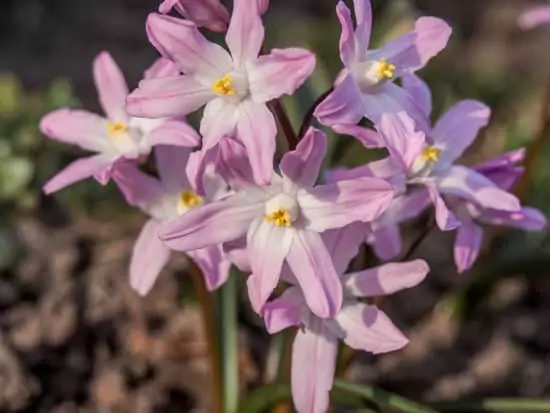
How to Grow Glory of the Snow?
Growing the glory of the snow is easy, but let’s go through the most important steps in planting and caring for this stunning flower.
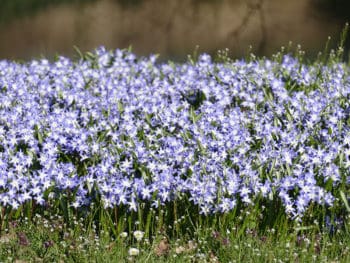
Ideal Location
Pick the spot for the Chionodoxa of the snow that has good drainage. If the soil is soggy, the bulbs can rot. Generally, most of the glory of the snow varieties enjoy the sun. Therefore, find the spot that gets at least six hours of sun per day.
Additionally, I have my glory of the snow planted under forsythia, but you can plant them under other deciduous trees or shrubs, such as flowering almonds. They will make their colonies quickly and cover a large surface.
How to Store Bulbs?
The Chionodoxa is best when planted from the bulbs. You can order bulbs online or buy them in the local nursery. Generally, once you get the bulbs, it is useful to plant them as soon as possible to prevent losing moisture.
If you cannot plant the bulbs immediately after receiving them, place the bulbs on a sawdust tray in a cool place.
Make sure that the temperatures are above 40 degrees Fahrenheit, as exposed bulbs are sensitive to cold temperatures.
How to Plant Bulbs?
Once you have decided on a location, you should dig a hole for each bulb you want to plant. Most varieties will grow well planted in 3-inch deep holes and around 3 inches apart from other bulbs. Also, the ideal time for planting the glory of the snow bulbs is fall.
Before you plant the bulbs, you can loosen the soil up with an organic fertilizer. Next, you can use a trowel or bulb planter to simplify the process. Or place the bulbs in the hole by hand, put the top of the bulb upward, and fill the hole.
You can also use flower fertilizer 10-10-10 once you fill the holes. Water the soil for 15 seconds after planting and once a week for the first month.
One tip I learned from other similar plants is that if you aren’t sure what the top of the bulb is, you can plant it on the side, and let nature do the rest.
The alternative is digging a deeper hole and putting all bulbs at once. Then, cover them with soil as well. This method might seem easier, but your plants won’t grow in the desired shape.
Let’s see this video to collect more understandings:
Planting Glory of the Snow From Seeds
The alternative to planting bulbs is growing the glory of the snow from seeds. The method is a bit more complex than planting bulbs, and it also takes a couple of years for the plants to develop and bloom to their full potential.
I recommend planting Chionodoxa from bulbs, but if you want to grow it from seeds, here is how to do so.
First, the packet of the glory of the snow usually includes five or six seeds, and to complete the look of your garden, you will need several packets.
You can sow the glory of the snow seeds any time in the year. Once you sow them, you can cover them with a 5mm layer of compost. Then, keep the pot in a cool, outdoor spot that gets at least several hours of direct sunlight.
The glory of the snow doesn’t need artificial heat to germinate, but the process is slow. Some varieties will wait for the spring to germinate, no matter when you sow them.
I recommend growing individual seedlings in compact pots until the plants are ready for larger pots or open ground.
How to Maintain Glory of the Snow?
Once you planted the bulbs in the fall, wait until winter to mulch the garden bed. That is all you need to do to protect the bulbs and boost the growth of the spring. Let the bulbs rest until the spring.
The glory of the snow requires simple maintenance, and effortlessly, the plant will provide satisfying results. During the spring, if there are no rainfalls, you can water the soil once a week.
Furthermore, the plant will benefit from an appropriate bulb fertilizer. However, the plant will be good even if you skip this step.
The glory of the snow doesn’t require pruning. Once the flowers are gone, the plant will die down and wake up next year before the blooming season. Still, you should leave the foliage on the plant after the blooming season, as it will help the plant to gather as much solar energy to survive winter and prepare for spring growth.
Also, your plant needs to divide once every several years.
Next, at the beginning of the spring, when you notice leaves, you can add fertilizer one more time to ensure healthy flowering. Still, even if you skip this step, the flowers will emerge, but maybe a day or two later.
Water the plants once a week until you see the first stunning flowers, and keep the same watering schedule until the flowers fall off.
Once they are done, you can deadhead the plant, but this step is optional.
Still, remember to keep the foliage on the plant for six more weeks. They help the plant to retain energy and come back stronger next season.
Can You Grow the Glory of Snow in the Container?
It is possible to grow the glory of the snow in a container, and the process isn’t any different from growing it in the garden. Still, keep in mind that you will need a container with at least an 8-inch diameter. It will ensure that the bulbs have enough space to develop.
Furthermore, make sure that there are draining holes in the pot.
Conveniently, you can plant several bulbs in one container, apply organic fertilizer, and water the bulbs.
The process is simple, but because the glory of snow is self-seeding, it will create a more beautiful effect when planted in open ground. It will spread fast and create a carpet of beautiful flowers in the spring.
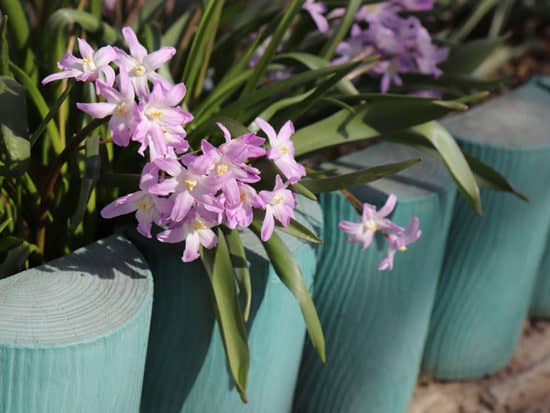
Pests and Diseases
As I mentioned before, the plant is very resilient, and it isn’t prone to pests and diseases.
Also, the plant is deer-resistant, and the critters don’t find it very attractive. Therefore, if you have an issue with chipmunks and squirrels, you can safely plant the glory of the snow.
But, there is one issue that you can experience with Chionodoxa.
If you overdo the fertilizer, the bulbs may start rotting due to large amounts of nitrogen.
Furthermore, soggy soil or extremely poor quality soil may cause the same issues. So, make sure that the soil is well-draining.
Also, if you damage the bulbs upon planting them, rotting can appear as a consequence.
How to Use Chionodoxa in Your Garden?
The Chionodoxa is a wonderful, early-blooming flower that quickly spreads on the open ground. There are numerous ways how you can incorporate the glory of the snow with other plants to create a beautiful, colorful garden.
One way is to plant the bulbs on the borders of your garden or on the bald spots. Because the flowers of all varieties are gentle and pastel, the plant will look great with almost all other flower colors.
You can use the glory of the snow as a blooming carpet on your lawn, in slopes, or like me, under a deciduous tree. If you have large space to cover, I recommend planting from 50 to 100 bulbs to get a spectacular flower carpet.
It is a great addition to rock gardens and sunny woodland borders as well.
The common companions for the glory of the snow are other similar, early-blooming spring bulbs. Those include snowdrops, Crocus, tulips, and daffodils.
For example, colorful yellow daffodils will look charming around gentle white Chionodoxa in the large space.
Additionally, if you pair violet Crocus with violet-blue flowers of the glory of the snow, you can create a stunning monochromatic garden.
Can You Use Lasagna Planting for Glory of the Snow?
If you have ever wanted to try lasagna planting, the glory of the snow is a perfect plant for it.
Basically, lasagna planting is a gardening technique that results in rich soil that requires no maintenance from the gardener in the future. It comes down to mixing different layers of organic matter. Eventually, the soil layers will mix over time and become fertile soil, full of beneficial microorganisms and other life forms. Moreover, the lasagna method doesn’t require digging or tilling.
Chionodoxa works well when combined with narcissus bulbs.
You can find medium-size containers and fill one layer with gravel then, add a thick soil with the first bulb. Add the layers of bulbs until you fill the container to the top. Mulch and water the pot.
Can You Grow the Glory of the Snow Indoors?
You can force the glory of the snow to blossom indoors, but the process is a bit tricky. You can put the bulbs in during October. Find the pot with drainage holes, but cover them with crushed crockery.
When planting, use several bulbs and plant them close to each other. However, the bulbs should be close but not touching. Again, keep the bulb facing upwards and make the upper point stick out from the soil.
Water the bulbs and place them in dark and cold space. Ideally, the temperature should be between 38 and 45 degrees Fahrenheit.
Keep the soil moist and once the roots emerge from the holes, put the pots in a colder room in the light.
You should turn the pots every day to make sure every part of the plant catches the light.
When you notice foliage on the stems, you can move the pot to an even warmer location. If you have done everything correctly, the plant will start blooming.
To prolong the blooming period, you can move the plant to a sunny indoor location.
Pick Glory of the Snow for Enchanting Garden in Spring
The glory of the snow is effortless to grow, but make a beautiful flower carpet on your lawn or rock gardens. You can grow it from bulbs, which is much simpler than growing it from the seeds.
Chionodoxa blooms early in the spring and its gentle flowers are the first sign that the cold winter is over. There are several varieties with colors in pink, purple, white, and blue color widely available in the nurseries.
Which color would you choose for your lawn? Share the article with like-minded people and help them grow these beautiful flowers!
